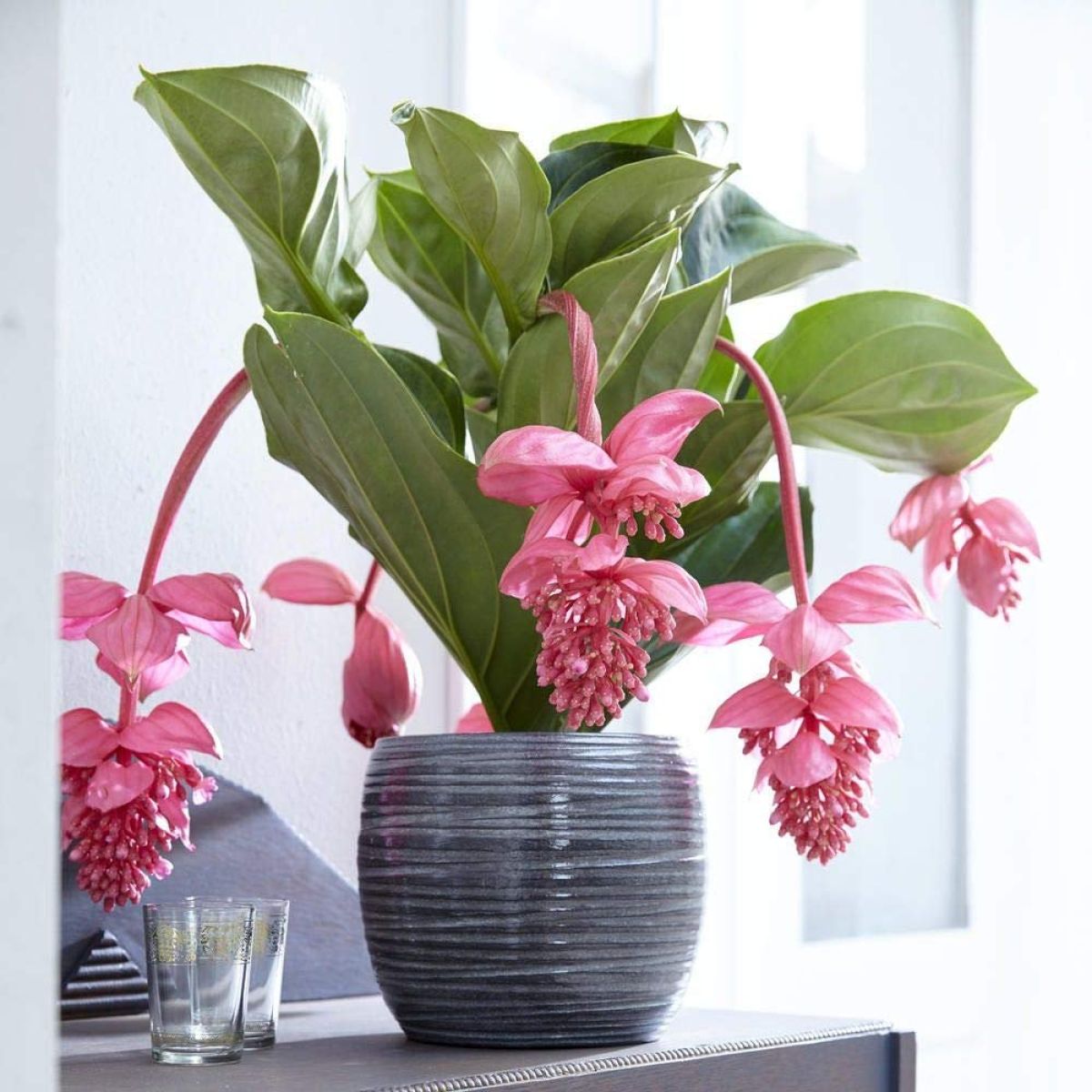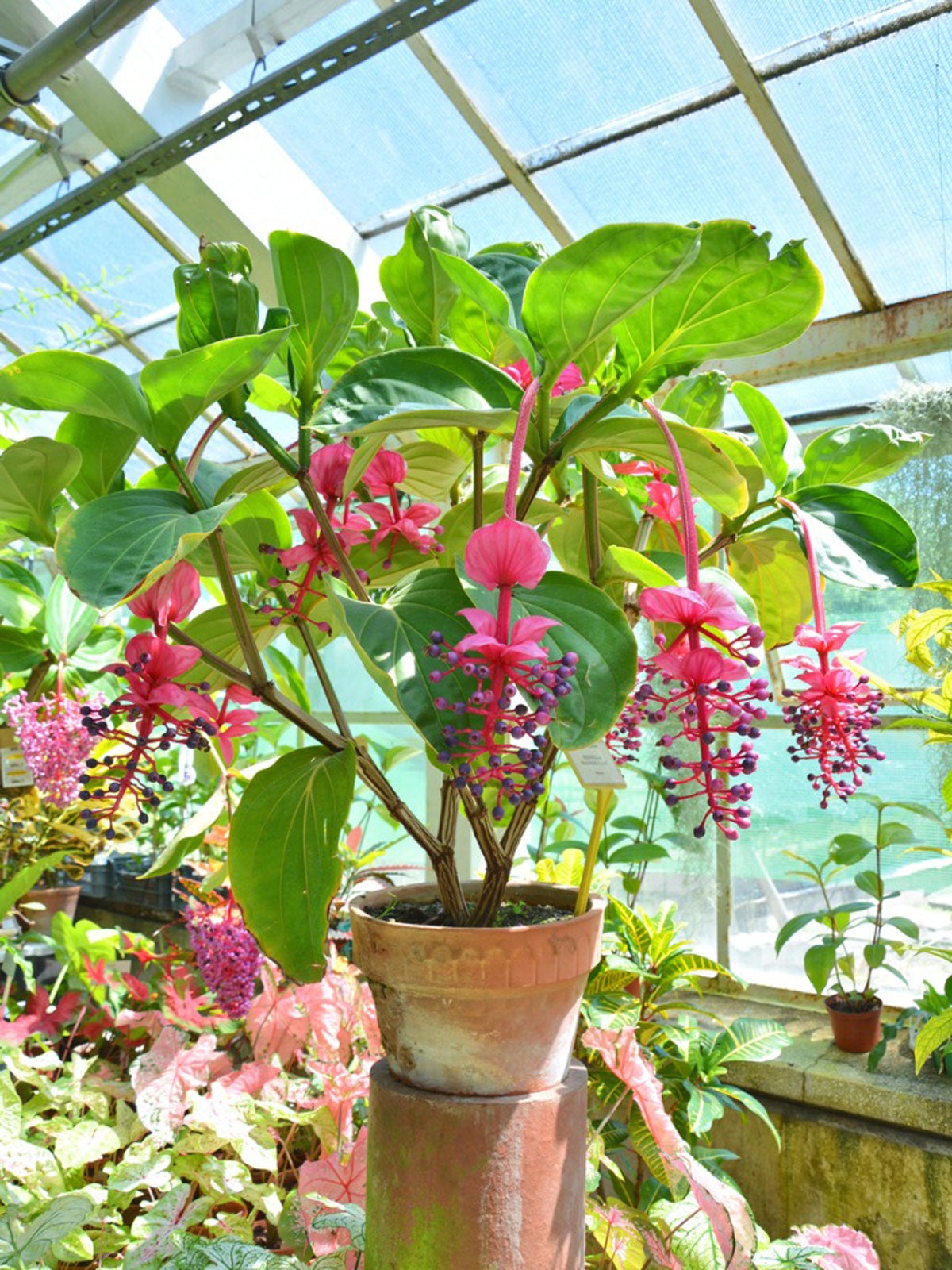Alright, let’s dive into the fascinating world of Medinilla and how it can spruce up your indoor jungle!
Medinilla Magnifica: The Showstopper of Your Indoor Garden
Ever laid eyes on a plant that just makes you stop and stare? Well, chances are you might have stumbled upon a Medinilla magnifica. This isn’t your average leafy green friend; it’s a true botanical beauty, often called the “Rose Grape” or “Pink Lantern Plant” for good reason. Native to the humid rainforests of the Philippines, this epiphyte (meaning it often grows on other plants in the wild, but don’t worry, it’s perfectly happy in a pot!) brings a touch of exotic elegance to any space.
What makes the Medinilla so captivating? It’s those incredible, cascading clusters of pink, grape-like flowers. These aren’t your fleeting blooms either; they can last for weeks, sometimes even months, transforming your living room into a tropical paradise. The flowers dangle gracefully beneath large, leathery, and deeply veined leaves, creating a stunning visual display even when it’s not in full bloom. The foliage itself has a lovely, almost architectural quality, adding texture and interest to your plant collection.

Now, while it might look like a high-maintenance diva, the Medinilla isn’t actually all that fussy once you get the basics right. Think of its native habitat: warm, humid, and bright but indirect light. Replicating these conditions indoors is key to keeping your Medinilla happy and encouraging those spectacular blooms.
Light: Finding the Sweet Spot
Medinilla loves bright, indirect light. Think of the kind of light you’d get near an east or west-facing window, or a bit further back from a south-facing one. Direct, harsh sunlight can scorch those beautiful leaves, leaving unsightly brown patches. If you notice the leaves looking pale or the plant isn’t flowering, it might not be getting enough light. You can supplement with a grow light during the darker months, especially here in the UK where winter days can be quite gloomy.
Watering: The Balancing Act

Watering is where many plant parents can go wrong, and the Medinilla is no exception. It likes its soil to be consistently moist but never waterlogged. Overwatering can lead to root rot, which is a big no-no for any plant. A good rule of thumb is to water when the top inch or two of soil feels dry to the touch. Make sure your pot has good drainage so excess water can escape. During the winter months, when the plant’s growth slows down, you can reduce the frequency of watering.
Humidity: A Taste of the Tropics
Coming from a humid environment, Medinilla thrives in higher humidity levels. Dry air, especially common indoors during winter with central heating, can make the leaves turn brown and crispy. You can increase humidity in several ways: using a humidifier, placing the pot on a pebble tray filled with water (making sure the bottom of the pot isn’t sitting directly in the water), or by misting the plant regularly with lukewarm water. Grouping your plants together can also help create a more humid microclimate.
Temperature: Keeping it Comfortable

Medinilla enjoys average room temperatures, ideally between 18°C and 24°C (65°F and 75°F). Avoid placing it near drafts or sudden temperature fluctuations, which can stress the plant. Keep it away from radiators or cold window sills.
Soil and Potting: Giving it a Good Foundation
A well-draining potting mix is crucial for Medinilla. An orchid mix or an aroid mix, which typically contains bark, perlite, and coco coir, works well. These mixes allow for good aeration around the roots, preventing them from staying too wet. When it comes to repotting, Medinilla doesn’t need it often. Only repot when it becomes root-bound, usually every couple of years, and choose a pot that’s only slightly larger than the previous one.
Feeding: A Little Boost
During the active growing season (spring and summer), you can feed your Medinilla with a balanced liquid fertilizer diluted to half strength every two to four weeks. Hold off on fertilizing during the dormant winter months. Over-fertilizing can lead to salt buildup in the soil, which can damage the roots.
Pruning: Shaping and Encouraging Blooms
While not strictly necessary, you can prune your Medinilla after it has finished flowering to maintain its shape and encourage bushier growth. Simply trim back the spent flower stems.
Propagation: Making More Medinillas
If you’re feeling adventurous, you can propagate Medinilla through stem cuttings. Take a cutting with a few leaves and nodes, dip the cut end in rooting hormone, and plant it in a moist potting mix. Keep it in a warm, humid environment until it develops roots.
Common Issues: Keeping an Eye Out
While generally resilient, Medinillas can occasionally encounter pests like spider mites or mealybugs. Keep an eye out for any signs of infestation, such as webbing, sticky residue, or small white cottony bugs. Treat any infestations promptly with insecticidal soap or neem oil. Leaf drop can sometimes occur due to underwatering, overwatering, low humidity, or sudden changes in temperature. Observing your plant closely will help you identify and address any issues early on.
In conclusion, the Medinilla magnifica is more than just a houseplant; it’s a living piece of art that can bring a touch of tropical grandeur to your home. While it appreciates specific care, understanding its needs for light, water, and humidity will reward you with stunning foliage and those breathtaking cascades of pink blooms. It’s a plant that truly earns its place as a showstopper in any indoor garden.
Frequently Asked Questions About Medinilla
How long do Medinilla flowers typically last?
The beautiful blooms of a Medinilla can last for several weeks, and in some cases, even a couple of months, providing a long-lasting display of color.
Is Medinilla difficult to care for?
While Medinilla has specific needs regarding light, water, and humidity, it’s not considered overly difficult once you understand these requirements and provide a consistent environment.
Can I grow Medinilla outdoors in the UK?
Due to the UK’s cooler climate and potential for frost, Medinilla is best grown indoors as a houseplant where its preferred warm and humid conditions can be maintained.
Why isn’t my Medinilla flowering?
Lack of sufficient bright, indirect light is the most common reason for a Medinilla not to flower. Ensure it’s receiving adequate light and consider a balanced fertilizer during the growing season to encourage blooms.
Are Medinilla plants toxic to pets?
Generally, Medinilla plants are considered non-toxic to cats and dogs, making them a safer choice for pet owners compared to some other flowering houseplants.
